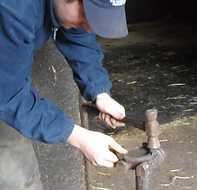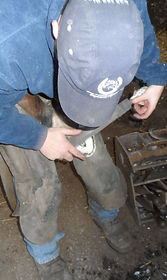Scott Williams Dip.WCF
Registered Farrier

PROFESSIONAL, RELIABLE & FRIENDLY SERVICE
Putting The HORSE First
Services
I'm working with you, to keep your horse performing at their best. I have many years of experience working with horses, ponies and donkeys hoofs from the high performance horses to the happy hack horses, also patient with Nervous and young horses.
Whether you require standard shoeing, barefoot trimming or in-depth corrective shoeing working alongside your vet then I have it covered.
Hot and Cold Shoeing
There are many different types of shoes. You can use steel shoes, aluminium shoes, plastic shoes, you could even build a temporary shoe with fast-setting urethane adhesive around the edge of the hoof.
There are also many different styles of shoes. Some have a single clip, some have two clips and some shoes have no clips, these are often referred to as natural balance shoes. Some horses have conformational limb abnormalities which affect the hoof growth, in these cases remedial shoes are needed such as the bar shoes, which gives 360 degree support to the foot. There is an endless list of therapeutic shoes that can be forged to help improve or support the horse’s conformation abnormality by a qualified Farrier.
Hot and Cold Shoeing
Corrective and Therapeutic Shoeing
Trimming/Barefoot Trimming
Trimming
It is crucial to remember that the trimming of the equine foot is fundamentally the most important part of Farriery.
Whether the foot is being trimmed for the application of a shoe or for a horse that is to be used barefoot, it is of fundamental importance that it be done correctly by a qualified Farrier or Veterinary Surgeon. If a foot is trimmed incorrectly then this can cause uneven stresses being put on the hoof capsule and consequently the limb. Over a period of time, depending on the severity of any imbalance the detrimental effect on muscles, tendons, ligaments, joints and the skeletal frame will result in lameness. A horse that is trimmed correctly (for the application of a shoe or for 'barefoot' use) will be sound afterwards. If the horse goes lame then it has been incorrectly trimmed. Always remember - Lameness = Pain!
Barefoot Trimming
I like to see a horse going unshod or barefoot where possible and I am happy to trim feet correctly for clients that wish to go barefoot. I only shoe client’s horses if the work they require the horse to do causes the hoof to wear away quicker that it can be grown. It’s that simple.
There are now however, a growing number of untrained, unqualified 'Barefoot Trimmers' and 'Equine Podiatrists' (no training that is currently available to a 'barefoot trimmer' is recognised by The Worshipful Company of Farriers or the Royal College of Veterinary Surgeons in the UK) that are not just trimming horses feet, but are attempting to cause remodelling the hoof capsule so that the horse can be worked unshod. Unfortunately this 'remodelling' of the hoof capsule commonly causes the horse to go lame afterwards. The owners are then told that this is normal and part of the 'transitional period' the horse must go through until its feet get used to being barefoot. But as Lameness = Pain then how can this be right? It’s simple, it’s not! They also insist that every horse can not only be left barefoot but can also be worked barefoot, with no need for any horse to be shod, again this is untrue. It is worth bearing in mind that in most countries as in the UK, it is illegal to knowingly cause pain or suffering to an animal!
Corrective and Therapeutic Shoeing
Corrective shoes have a wide variety of applications and can both prevent lameness as well as help cure or reduce lameness problems.
Some corrective shoes such as straight bars can be fitted upon assessment of a horse where visual diagnosis can be achieved whether this is as proactive or reactive measure. Other types, such as the heart bar can often require the expertise of a Vet as x-rays can be necessary prior to the application of this type of shoe. This is due to how accurately they have to be fitted for certain conditions/problems. An incorrectly fitted heart bar shoe could be fatal to a horse if you are putting load on the bar.
I will always advise clients when I think any corrective work is required on their horse. I will if necessary instruct the client that I wish their Vet to be involved in the diagnosis and prognosis of a condition and state whether x-rays of the horses lower leg and/or foot are required.



